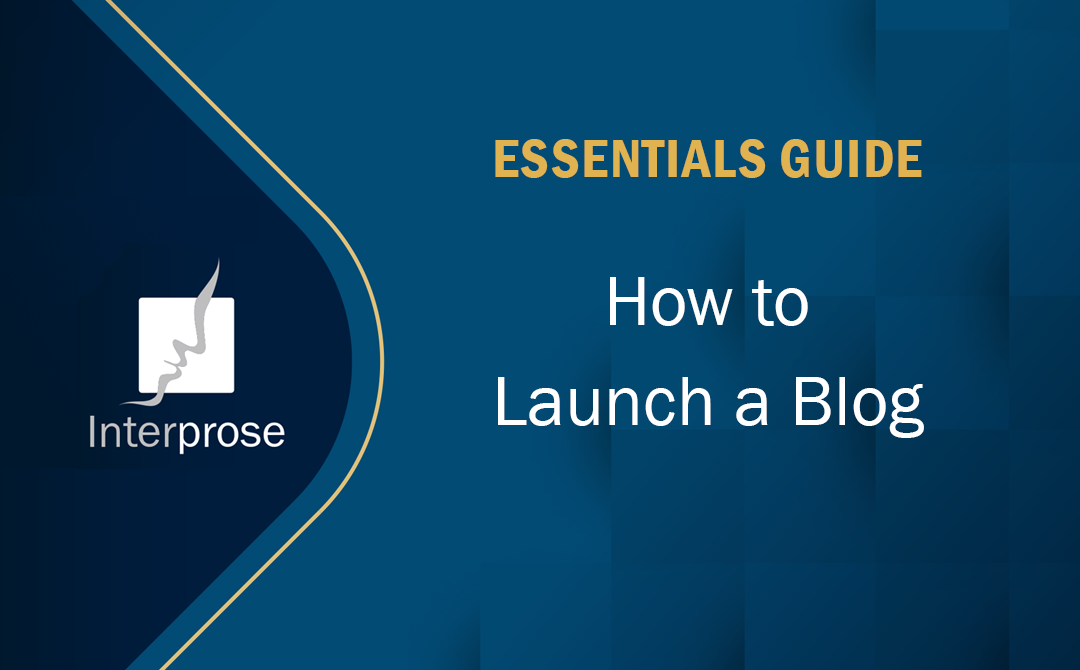ESSENTIALS GUIDE
How to Launch a Blog
A blog can be a powerful, effective marketing and communications vehicle for your organization. The benefits are many: You control the topics, timing, content and messages for a targeted audience. You build brand awareness, company and executive credibility, and provide social media fodder.
However, it is no small undertaking to plan and launch a blog (or perhaps it is a re-launch of a blog that’s gone stale). And once launched, the “care and feeding” of your blog is equally as critical for ongoing success.
This Interprose Essentials Guide will lead you through the planning and launch steps to help get your blog off the ground.
[divider top=”no” text=”Go to top” style=”default” divider_color=”#e0b250″ link_color=”#999999″ size=”2″ margin=”5″]PLANNING YOUR BLOG
 Determine the goals and objectives of the blog.
Determine the goals and objectives of the blog.
- Develop 3-5 goals
- Examples:
- Promote the company and its products/services
- Educate an audience
- Drive traffic to the website; keep visitors on the site longer
- Generate leads
Make a list of potential contributors, then conduct outreach. Make sure to convey the benefits (e.g., personal brand building, social media fodder).
- Internal subject-matter experts
- Company executives
- Customers
- Partners
- Volunteers and members
- Industry analysts
- Industry influencers
Set goals for the frequency of posts.
- One per week is optimal, but at a minimum target 2x per month.
- Quality and quantity are both important. Types of posts may include:
- Fresh perspectives
- Industry trends
- “How tos”
- Technical content
- Event coverage
 Create an editorial calendar. Plot out your topics by month. Work in advance to ensure you
Create an editorial calendar. Plot out your topics by month. Work in advance to ensure you
have a pipeline of varied content and authors approved and ready to publish.
Develop editorial guidelines.
- Define:
- Audience and content objectives
- SEO optimization techniques (e.g., use of keywords)
- Topic approval process
- Desired length
- Style and format
- Linking policy
- Image and graphics guidelines
- Publish the guidelines on your blog.
Establish a review board/team and approval process. This will help ensure posts meet your performance objectives
and editorial guidelines. Ensure a quick turnaround of content review.
 Define how you will measure performance and success.
Define how you will measure performance and success.
- Set up performance metrics in advance
- Map them to your blog goals and objectives.
BLOG STRUCTURE AND STYLE
Spend time up front developing the blog taxonomy.
- Make the blog searchable by author and by topic
- Develop content categories to improve user navigation. Assign each post to a category.
- Include tags for each article—these “index words” will help with navigation in a category and provide more detail about a post.
Research and identify other blogs that can provide a guide for style, content, top-performing posts, etc.
[divider top=”no” text=”Go to top” style=”default” divider_color=”#f3e0b9″ link_color=”#999999″ size=”1″ margin=”2″]Essential Steps:
- Name the blog to give it an identity.
- Establish a voice and style for the blog. Include that information in your editorial guidelines.
- Date the blogs.
- Make posts skimmable and mobile friendly.
 Include short bios and headshots for all authors.
Include short bios and headshots for all authors.- Include visuals including videos, photos and graphics with every post.
- Each post should contain links to other resources, with a mix of internal and external links.
Have 3-5 articles ready to post at launch to ensure a healthy pipeline.
[divider top=”no” text=”Go to top” style=”default” divider_color=”#e0b250″ link_color=”#999999″ size=”2″ margin=”5″]
